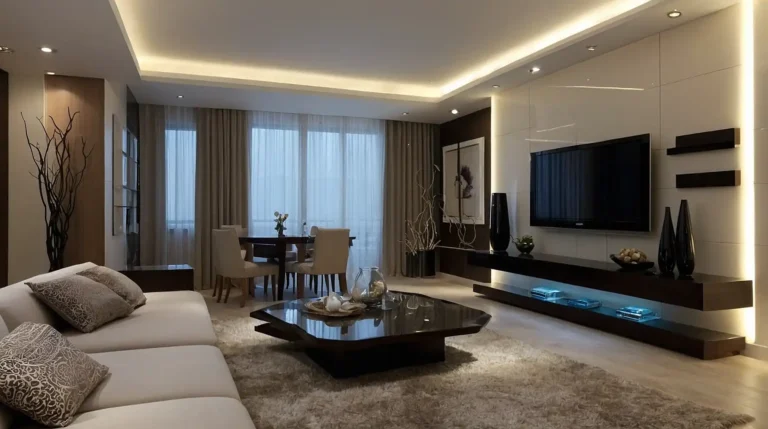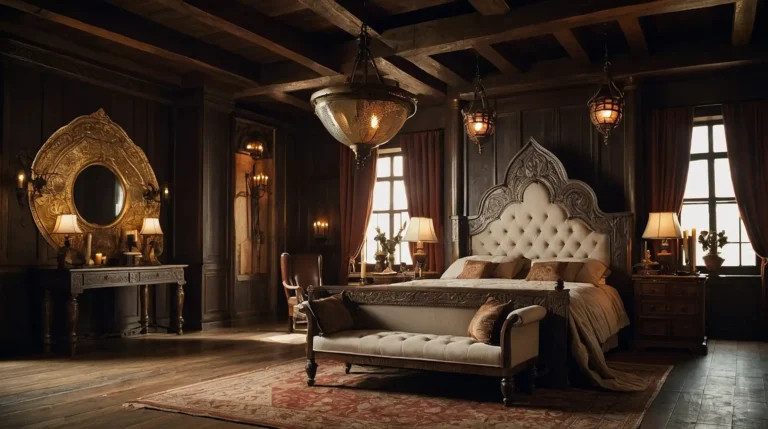27 Captivating Old Mexican House Ideas to Infuse Your Home with Timeless Charm
Traditional Mexican architecture combines Spanish colonial influence with indigenous craftsmanship to create homes of extraordinary character and warmth.
These historic designs offer timeless elements that you can incorporate into your own home, whether you’re building from scratch or renovating.
From vibrant color palettes to handcrafted details, these old Mexican house ideas will help you capture the authentic charm and welcoming atmosphere that makes this architectural style so enduringly appealing.
1: Interior Courtyard (Patio Central)

Transform your home’s layout with a central courtyard that serves as the heart of the house.
This quintessential Mexican design element creates a private outdoor oasis while improving air circulation and bringing natural light into surrounding rooms.
Plant flowering vines, install a small fountain, or add colorful pottery to enhance the authentic courtyard experience.
2: Terracotta Roof Tiles

Crown your home with classic terracotta roof tiles to instantly capture old Mexican architectural character.
These durable clay tiles develop a beautiful patina over time while providing excellent insulation against both heat and cold.
Their distinctive wavy profile creates dynamic shadow patterns that bring your roof to life throughout the day.
3: Talavera Tile Accents

Incorporate handpainted Talavera tiles on stair risers, kitchen backsplashes, or bathroom walls for instant Mexican charm.
These colorful ceramic tiles feature intricate patterns and vibrant colors that have characterized Mexican homes for centuries.
Mix and match different designs or create a cohesive pattern—either approach delivers authentic cultural heritage to your space.
4: Thick Adobe Walls

Construct exterior walls using traditional adobe or modern alternatives that mimic their substantial appearance and thermal properties.
These thick walls create deep window reveals that cast beautiful shadows while maintaining comfortable indoor temperatures naturally.
Paint them in warm earth tones or brilliant white to highlight their impressive solidity and organic texture.
5: Exposed Wooden Beams (Vigas)

Install rustic wooden ceiling beams to create architectural interest and authentic Mexican character overhead.
These structural elements, traditionally made from pine or cedar, add warmth and textural contrast to plastered ceilings.
Leave them natural or distress them to simulate the weathered appearance of centuries-old hacienda beams.
6: Wrought Iron Details

Incorporate ornate wrought iron elements in window grilles, stair railings, and light fixtures throughout your home.
These decorative yet functional features provide security while showcasing the blacksmith’s artistry traditional in Mexican architecture.
Choose designs featuring scrollwork, floral motifs, or geometric patterns that complement your home’s overall aesthetic.
7: Arched Doorways and Windows

Replace standard rectangular openings with graceful arches to instantly evoke colonial Mexican architecture.
These curved elements soften transitions between spaces while creating distinctive sight lines throughout your home.
Emphasize their shape with contrasting paint colors or decorative tile surrounds for maximum visual impact.
8: Colorful Exterior Palette

Paint your home’s exterior in the vibrant color combinations characteristic of traditional Mexican neighborhoods.
Bold terracottas, cobalt blues, sunshine yellows, and rich ochres create a welcoming façade that stands out beautifully.
Accentuate architectural details like door frames, window surrounds, and columns with contrasting colors for authentic character.
9: Carved Wooden Doors

Install a substantial wooden front door featuring hand-carved panels to make a striking first impression.
These magnificent entryways serve as artistic focal points while honoring the master carpentry traditions of Mexican craftsmanship.
Choose designs featuring geometric patterns, religious motifs, or botanical elements depending on your personal style.
10: Clay Brick Floors (Ladrillo)

Replace conventional flooring with handmade clay brick tiles for authentic character and natural cooling properties.
These rustic floor coverings develop a beautiful patina over time that tells the story of your home’s daily life.
Seal them properly to maintain their earthy beauty while protecting them from stains and wear in high-traffic areas.
11: Nichol Wall Alcoves

Carve small decorative niches into thick walls to display religious icons, candles, or treasured objects.
These charming recessed shelves transform ordinary walls into opportunities for personal expression and cultural significance.
Frame them with decorative tile, paint them in contrasting colors, or add small architectural details for enhanced visual impact.
12: Open-Air Living Room (Sala)

Design a covered outdoor living space that serves as a breezy transition between indoors and garden areas.
This traditional feature encourages indoor-outdoor living while providing shade and protection from sudden rain showers.
Furnish with comfortable seating, potted plants, and hanging hammocks for authentic Mexican leisure at home.
13: Timbered Ceilings (Tejabanes)

Install wooden plank ceilings supported by exposed beams to create rustic overhead interest in your home.
This traditional ceiling treatment adds warmth and acoustic benefits while showcasing authentic construction techniques.
Stain the wood to highlight its natural grain patterns or whitewash it for a more contemporary interpretation.
14: Hand-Plastered Walls

Apply traditional lime plaster or modern equivalents to create the softly textured wall surfaces of historic Mexican homes.
These imperfect finishes reveal subtle handwork that adds depth and character impossible to achieve with flat paint.
Choose warm white or subtle earth tones that showcase the gentle undulations and organic nature of the plastered surface.
15: Cantera Stone Columns

Incorporate natural stone columns, traditionally carved from volcanic cantera stone, on porches, entryways, or interior arcades.
These structural elements add grandeur while displaying the characteristic craftsmanship of colonial Mexican architecture.
Choose simple cylindrical forms for a understated look or ornately carved designs for more dramatic architectural impact.
16: Kitchen Hearth (Fogón)

Install a traditional cooking hearth or its modern equivalent as the focal point of your Mexican-inspired kitchen.
This architectural feature honors the historical center of Mexican home life where family meals were lovingly prepared.
Surround it with handmade tiles, display copper cookware nearby, or incorporate built-in niches for spices and cooking tools.
17: Tropical Interior Courtyard Garden

Transform your interior courtyard into a lush oasis with tropical plants traditional in Mexican residential landscapes.
Incorporate banana trees, bougainvillea, citrus trees, and fragrant herbs to create a multi-sensory garden experience.
Add classic terra cotta planters and colorful ceramic pots to enhance the authentic atmosphere of your private paradise.
18: Bovisa Ceilings

Install curved brick or plaster ceiling vaults that create dramatic overhead architecture without requiring wood.
These graceful arched structures distribute weight ingeniously while adding distinctive character to your living spaces.
Leave them exposed to showcase their geometric precision or plaster over for a smoother, more contemporary interpretation.
19: Bovids Ceilings

Install hand-carved cantera stone sinks in kitchens or bathrooms to add instant architectural character.
These substantial basin fixtures combine practical function with sculptural beauty that elevates ordinary daily rituals.
Choose traditional designs with floral motifs or geometric patterns that complement your overall decorative theme.
20: Wooden Window Shutters

Replace contemporary window treatments with authentic wooden shutters that control light and ventilation naturally.
These practical elements allow you to adjust airflow and privacy while adding architectural interest to both interior and exterior.
Paint them in bright accent colors for traditional contrast against white walls or leave them natural for rustic charm.
21: Equip ale Furniture Tradition

Furnish your Mexican-inspired home with traditional equipale chairs and tables made from pig hide and cedar strips.
These indigenous furniture pieces bring authentic cultural heritage into your living spaces with their distinctive barrel shapes.
Pair them with colorful textiles and pottery for an eclectic yet cohesive look that honors Mexico’s diverse design traditions.
22: Zaguan Entryway

Design a traditional zaguán—a transitional passage between street and interior courtyard—to create dramatic arrival experience.
This architectural feature typically includes a substantial wooden door opening to a cool, shaded corridor leading to the heart of the home.
Pave it with traditional clay tiles, adorn with wall niches, or install a small fountain to enhance the sensory journey inward.
23: Roof Parapets with Scalloped Edges

Crown your home with decorative parapets featuring curved or geometric cutouts along the roofline.
These distinctive architectural elements create dynamic shadows while hiding utilitarian roof elements from street view.
Paint them in contrasting colors or cap with additional decorative tile work for maximum visual impact against the sky.
24: Enclosed Prayer Corner (Altar)

Dedicate a small corner or niche for a traditional family altar displaying religious icons, candles, and meaningful objects.
This cultural feature honors the spiritual traditions central to historic Mexican home life across generations.
Frame it with decorative tilework, add small shelves for offerings, or incorporate special lighting to enhance its significance.
25: Clay Pot Drainage Spouts (Gárgolas)

Replace standard rain gutters with decorative clay spouts that channel water away from the roof with artistic flair.
These charming functional elements create dynamic water features during rainstorms while adding authentic architectural detail.
Position them strategically to direct water into courtyard gardens or decorative catch basins for practical water management.
26: Covered Exterior Walkways (Portales)

Connect buildings or outdoor spaces with covered walkways supported by arched colonnades in traditional Mexican style.
These practical architectural features provide shade during hot days and shelter during sudden rain showers.
Pave them with traditional clay tiles, adorn with climbing plants, or hang lanterns for enchanting evening illumination.
27: Hand-Painted Folk Art Motifs

Incorporate hand-painted decorative elements inspired by Mexican folk art traditions on furniture, doors, or wall surfaces.
These vibrant designs featuring flowers, birds, and geometric patterns bring authentic cultural heritage into contemporary spaces.
Commission local artists to create custom pieces or try your hand at simple motifs using traditional color combinations.
Conclusion
These traditional Mexican design elements offer timeless beauty, functional wisdom, and cultural richness.
Incorporate one or several to create a home that honors this magnificent architectural heritage while meeting your modern needs.







